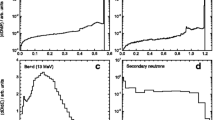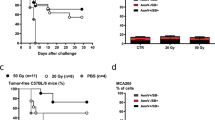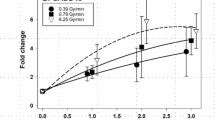Background and Purpose:
The relative biological effectiveness (RBE) of neutrons differs for various biological endpoints, and for various cell and tissue types. With respect to the apoptosis induction, a whole range of values can be found in the literature, but the decisive factors are not clear. Most previous studies have used apoptosis-prone hematopoietic cells, whereas tumor cells have received little attention. The authors therefore decided to investigate apoptosis induction caused by X-rays and neutrons in a line of human melanoma cells, at doses which are isoeffective for the loss of colony-forming ability.
Material and Methods:
Human melanoma cells Be11, expressing p53 wild-type protein, were used throughout. Exponentially growing cells were exposed to two pairs of isoeffective doses (at surviving levels 10% and 1%) of 240-kV X-rays and 5.8-MeV neutrons. 1–8 days after irradiation, the frequency of apoptosis in adherent cells was assessed by two-parameter flow cytometric analysis with a DNA-dye-exclusion annexin-V-binding assay as well as by morphological examination with DAPI staining.
Results:
Apoptosis was induced most significantly 6–7 days after irradiation. The time courses, as well as the magnitudes of apoptosis induction, after isoeffective doses of X-rays and neutrons with respect to loss of colony-forming ability appeared to be comparable. RBE values in the range of 4–5 were estimated for apoptosis 4–8 days after irradiation by both the annexin V assay and morphological examination.
Conclusion:
Radiation-induced apoptosis depends on ionization density in the same way as cell inactivation in general does, i.e., the RBE is similar, and the ratio of cells dying by apoptosis to cells dying otherwise does not depend on radiation quality.
Hintergrund und Ziel:
Die relative biologische Wirksamkeit (RBW) von Neutronen ist je nach biologischem Endpunkt und je nach Zell- und Gewebetyp unterschiedlich. In Bezug auf die Apoptoseinduktion bestehen große Diskrepanzen zwischen den Daten verschiedener Autoren, wobei nicht klar ist, welche die ausschlaggebenden Faktoren sind. Die meisten früheren Arbeiten wurden mit hämatopoetischen Zellen durchgeführt, die eine besondere Apoptoseneigung zeigen, während Tumorzellen weitgehend unbeachtet blieben. Daher beschäftigt sich die vorliegende Untersuchung mit der Apoptoseinduktion durch Röntgenstrahlen und Neutronen in einer menschlichen Melanomzelllinie. Sie vergleicht Effekte bei Dosen, die in Bezug auf den Verlust der Koloniebildungsfähigkeit isoeffektiv sind.
Material und Methodik:
Alle Experimente wurden mit der Melanomzellinie Be11 durchgeführt, die ein p53-Wildtypprotein exprimiert. Exponentiell wachsende Zellen wurden je zwei isoeffektiven Dosen von 240-kV-Röntgenstrahlen bzw. 5,8-MeV-Neutronen ausgesetzt, bei denen das Zellüberleben auf 10% bzw. 1% reduziert war. 1–8 Tage nach Bestrahlung wurde die Häufigkeit apoptotischer Zellen unter den noch angehefteten Zellen bestimmt, und zwar einerseits durchflusszytometrisch mit Hilfe des Annexin-V-Tests und andererseits durch morphologische Untersuchung nach DAPI-Färbung.
Ergebnisse:
Die Apoptosehäufigkeit stieg nach Bestrahlung an und erreichte nach 6–7 Tagen ein Maximum. Zeitverlauf und Ausmaß der Apoptoseinduktion waren bei isoeffektiven Dosen von Röntgenstrahlen und Neutronen vergleichbar. Es konnte abgeschätzt werden, dass die RBW für die Apoptoseinduktion 4–8 Tage nach Bestrahlung im Bereich von 4–5 lag. Das galt sowohl für den Annexin-V-Test als auch für die morphologische Untersuchung.
Schlussfolgerung:
Apoptoseinduktion hängt in gleicher Weise von der Ionisationsdichte ab wie die Zellinaktivierung im Allgemeinen, d.h., die RBW ist für beide Endpunkte ähnlich, und das Verhältnis von Zellen, die durch Apoptose sterben, zu Zellen, die durch andere Prozesse zugrunde gehen, ist unabhängig von der Strahlenqualität.
Similar content being viewed by others
Author information
Authors and Affiliations
Corresponding author
Rights and permissions
About this article
Cite this article
Oya, N., Zölzer, F., Werner, F. et al. Similar Extent of Apoptosis Induction at Doses of X-Rays and Neutrons Isoeffective for Cell Inactivation. Strahlenther Onkol 184, 270–275 (2008). https://doi.org/10.1007/s00066-008-1806-6
Received:
Accepted:
Issue Date:
DOI: https://doi.org/10.1007/s00066-008-1806-6




